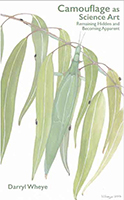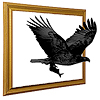| |
|
| |
Camouflage as Science Art:
Remaining Hidden and Becoming Apparent----a 27-page booklet presenting 10 examples of camouflage, ranging from insects to people. The booklet, designed for young and old, alike, is available through Amazon. Fifteen percent of the royalties are donated to Science Art-Nature.
|
| |
 |
| |
|
| |
The Connection Between Art, Healing, and Public Health: A Review of Current Literature by Heather L. Stuckey (Department of Medicine, Pennsylvania State University College of Medicine, Hershey) and Jeremy Nobel, MD, MPH (Department of Health Policy and Management, Harvard School of Public Health, Boston, MA). This paper concludes: "The more we understand the relationship between creative expression and healing, the more we will discover the healing power of the arts."
|
| |
Digital Display of Science Art in education----a six-image slide show was produced for Stanford University's Y2E2 Environment and Energy Building to highlight both local species as part of the Art at Exits project, and species involved in Y2E2 research efforts.
|
| |
Science Art in education----examples include early use in classes at Stanford University and current installations. For a brief discussion, see Science Art in Classrooms and Corridors. For more information about the Audubon installation, see Art at Exits.
|
| |
|
| |
Science Art in continuing education----examples of classes that combine science and art include a 6-week course called "The Big Picture: Visual Strategies for Effective Science Communication", which was offered for two years through the Stanford Continuing Studies Program. It covered core concepts of visual design and narrative for researchers, health care providers, educators, entrepreneurs... anyone challenged by the need to communicate complex science concepts effectively. More recenty modified versions of the course have been offered in workshops, and an online course, SPARK.
|
| |
 |
| |
The drug Tamiflu halting the progression of the influenza virus in flu sufferers. The drug (yellow) plugs the active site of an
important enzyme (red) on the virus surface (green), preventing the virus from replicating.
|
| |
|
| |
|
| |
Science Art production |
| |
Project Background Collisions was originally a four-piece ensemble, hand-drawn with ink but appears here as a digitally-edited single image. It was created within the pilot year of the Stanford Senior Reflection Program 2010-2011, which was led by Prof. Susan McConnell and Prof. Andrew Todhunter. The program was a forum to explore the connections between biology and the arts, and was open to all majors.
|
| |
|
| |
Collisions is an attempt to mesh the world of molecular biology of rheumatoid arthritis (RA) with the very human experience of living with the disease. RA is an autoimmune disease of the synovial joints, the most moveable joints in the human body, such as those found in the hands and knees. The disease causes pain and immobility due to inflamed synovial tissue growth that eats away at the cartilage and, in severe cases, the bone.
|
 Collisions by Catherine Le ©2012 ScienceArt-Biology Collisions by Catherine Le ©2012 ScienceArt-Biology
| |
I interviewed eight volunteers who shared their stories of diagnoses, treatments and perseverance. Chosen quotes from the interviews overlay a depiction of my own representation of RA from the tissue level down to the cellular and molecular levels. My goal was to create a visually appealing representation that honored the experiences and insights the patients shared during their interview. It was interesting to create an artwork capable of reversing the viewer’s initial expectations: It is the words of the patients, not their cells, that emerge when zooming into the image.
|
| |
|
| |
The Rollover is a zoomed in look at the second panel. This panel depicts the clash between the growing synovial tissue in the joint that begins to encroach and destroy the cartilage and bone. Synovial tissue in rheumatoid arthritis becomes inflamed and proliferating. Within it, there are cells that release chemical signals that cause reactions that eat away at the cartilage and eventually the bone. Within the cells of the cartilage on the left, a bold quote says, "It's hard to communicate what it's like to have RA." The theme of the second panel is miscommunication between patients and doctors and between those who are living with the disease and those who are not.
|
| |
|
| |
Artist Catherine Le graduated from Stanford University in 2011 with a degree in Biology and minor in English. She currently works at a genome database company in the South Bay and is still trying to find her path in the world.
|
|
 Science Art-Nature
Science Art-Nature Science Art-Nature
Science Art-Nature

